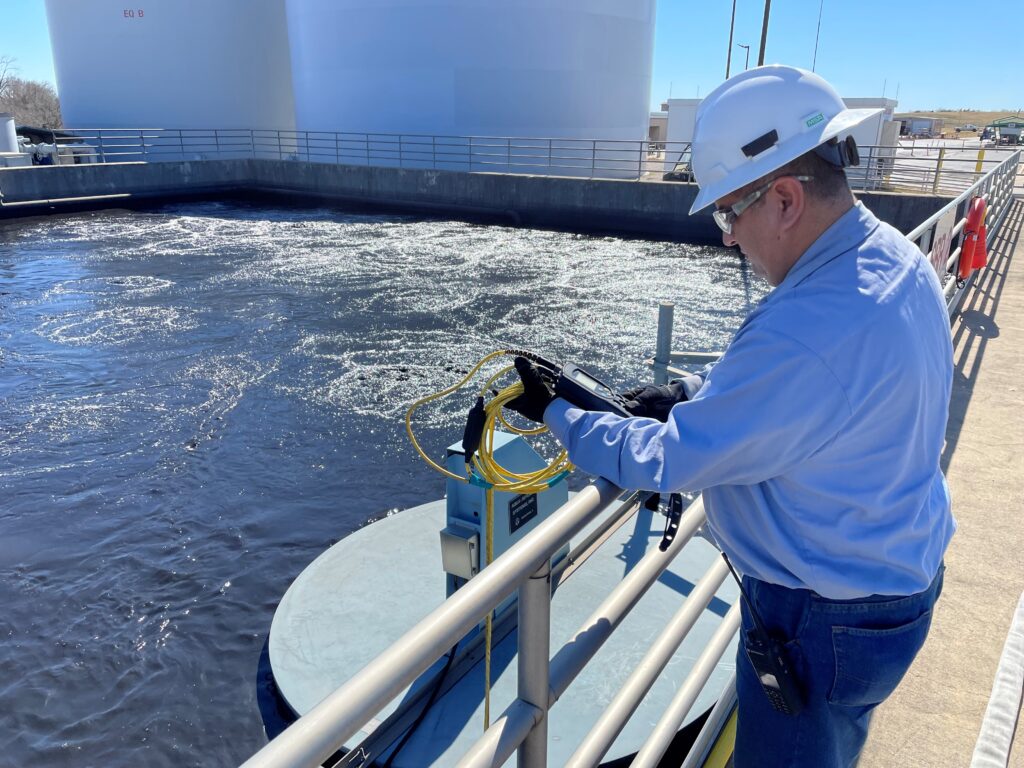A Delicate Balancing Act: Environmental Responsibility in Firefighter Training

When you hear about firefighter training, you might think that between the water, smoke and foam runoff, it would negatively impact the environment. But at TEEX’s Brayton Fire Training Field, the largest firefighter training field in the United States, they have environmental responsibility down to a science.
Instead of wasting millions of gallons of fresh water in training every day, the environmental engineers at TEEX have developed an industrial wastewater treatment plant so students can reuse it day after day. Last year, the plant treated nearly 226 million gallons of water, recycling and reusing more than 65% of that. They are able to do this with the help of millions of microbes that live in the water and eat the fuel and foam.
The microbes are living beings that need special care, like a pet. They thrive on the greasy fuel and firefighting foam in the water, and operators feed them ammonia and phosphorus for a balanced diet. Environmental Specialist Bill Latham calls them his minions and says, “If I keep them happy, I’m happy. They mostly like to reproduce and eat the greasy fuel and foam in the water.”
But during holidays or breaks in training, the microbes can die without their steady diet of fuel and foam. Howard Meek, Environmental Health and Safety Manager at TEEX, explains that during holidays, “We go down to the feed supply store and buy dog food in bulk, and the operators will feed it to the microbes to keep them healthy.”
This was especially problematic when COVID put training on hold for long periods. Meek describes, “We could tell we were starting to lose our bugs. Right before we really got into emergency mode, we started thinking outside of the box. Bill said we could use some wine or beer for them, so we started calling local wineries, and we said, ‘This is going to sound strange, but we need some stale wine.’ Messina Hof Winery brought us a 300-gallon tote of wine that had gone bad, and we set it up and slowly fed it into the plant. It kept our microbes alive and well until training resumed.”
TEEX’s industrial wastewater treatment plant came online in 2008 and is designed to treat up to 3.4 million gallons per day. Latham explains the enormity of this, saying, “There are a lot of municipalities that don’t even discharge that much water.” But to do this requires a delicate balancing act of ensuring water is ready for customer use, caring for the health of microbes, and meeting environmental permit requirements.
When students spray water and foam on fire props, it runs into cement ditches that flow to the plant, where it goes through several filters and where the bugs remove the fuel and foam. After circulating through the plant, water sits in holding ponds, waiting to be used in training again. Daily, the team has to ensure there is enough water and that the treatment was effective, or, in other words, the bugs did their job. Meek explains, “There are really a lot of behind-the-scenes calculations to keep the plant healthy and meet the customers’ daily needs.”
But it is not only water that Latham and Meek’s team monitor; they also maintain compliance with air, wastewater and stormwater permits. They consider the type of foam TEEX uses, which is more environmentally friendly than most foam used in actual firefighting. They monitor runoff to ensure that no foam contaminates the surrounding water and wildlife. Regarding the impact on air quality, the fire field’s fuel releases fewer pollutants, and they carefully monitor the air quality. Finally, they safely dispose of the fire field’s solid waste, including things like dry chemical and wood. The environmentally responsible design of TEEX’s fire field enables hands-on training and practice with water and foam while minimizing the impact on the environment. Meek explains that “without this kind of life-like training opportunity that TEEX provides with minimal impact to the environment, success in an emergency would be considerably less.” One of TEEX’s core values is safety, and Latham and Meek’s work demonstrates that that commitment extends not only to the safety of instructors, students and employees, but also to the health and safety of the community and the environment.
